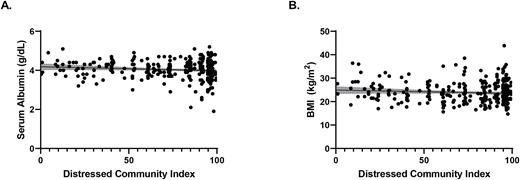Abstract
Introduction: Sickle cell anemia (SCA) is characterized by a myriad of acute and chronic complications. These complications negatively impact the ability to achieve educational and occupational goals making this group a particularly vulnerable population to socioeconomic challenges (PMID 30540112). Furthermore, most patients with SCA in the U.S. are Black and are disproportionately affected by socioeconomic inequity due to the historical effects of systemic racism (PMCID: PMC4817358). In the general population, indices of socioeconomic distress are associated with poor nutrition (PMID 25573510). Patients with SCA also experience a high frequency of food insecurity (PMID 34811867). The association of community-level socioeconomic distress with nutritional status in people with SCA is unknown.
Methods: We conducted a cross-sectional study to describe the burden of community-level socioeconomic distress and its impact on nutritional status in an SCA cohort (n=332) treated at an urban academic institution. The distressed community index (DCI), a composite of socioeconomic indicators (including no high school diploma, housing vacancy rate, adults not working, poverty rate, median income ratio, and changes in employment and establishments) that estimate the economic well-being of a community, was determined for each individual patient's residential address using 2014-2018 U.S. Census Bureau's American Community Survey and the Business Patterns database. DCI score ranges from 0-100 with a higher score indicating a more distressed community. The association of DCI with measures of nutritional status (serum albumin, body mass index [BMI], vitamin D 25-OH) and hemoglobin concentration were determined using linear regression. The analyses were adjusted for age, sex, and hydroxyurea use. The beta coefficients provided are based on increments of 10 for DCI. Median and interquartile ranges (IQR) are provided.
Results: The median age of the cohort was 31 years (IQR, 24-41 years), 55% were female, 53% were on hydroxyurea therapy, and the median BMI was 23 kg/m2 (IQR, 21-26 kg/m2). The median DCI in this cohort was 87 (IQR, 61-96) with 61% of SCA patients living in a distressed tier (DCI≥ 80) and only 5% living in a prosperous tier (DCI< 20). A higher DCI, reflecting an increase in socioeconomic distress, was associated with a trend for a lower odds ratio (OR) of being on hydroxyurea therapy (OR 0.93; 95% CI 0.86-1.0). An increasing DCI was significantly associated with lower serum albumin (β= -0.02; P=0.016), BMI (β= -0.01; P=0.045), and vitamin D 25-OH levels (β= -0.7; P=0.001), adjusting for age, sex, and hydroxyurea use (Figure). Furthermore, SCA patients living in a more distressed community had a trend for lower hemoglobin concentrations (β= -0.05; P=0.077) with similar adjustments.
Discussion: In conclusion, we demonstrate that a high proportion of patients with SCA treated at an urban academic institution live in distressed socioeconomic communities. Higher distressed community indices are associated with lower utilization of hydroxyurea and lower measures of nutritional status. Future studies investigating the effects of socioeconomic distress on access to outpatient care and healthy foods may guide public health strategies to improve health disparities in the SCA population.
Disclosures
Gordeuk:Forma: Consultancy; GSK: Consultancy; GBT: Consultancy, Research Funding; CSL Behring: Consultancy, Research Funding. Saraf:Global Blood Therapeutics: Consultancy, Research Funding, Speakers Bureau; Agios: Consultancy; Novartis: Consultancy, Membership on an entity's Board of Directors or advisory committees, Research Funding; ORIC: Consultancy; FORMA Therapeutics: Consultancy, Research Funding.
Author notes
Asterisk with author names denotes non-ASH members.


This feature is available to Subscribers Only
Sign In or Create an Account Close Modal